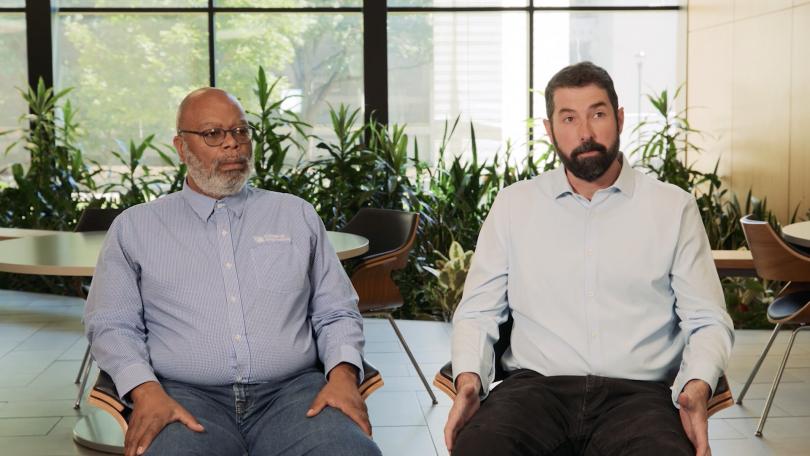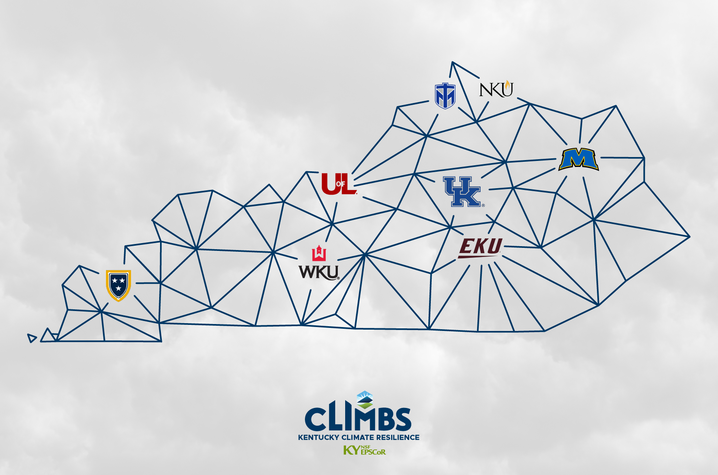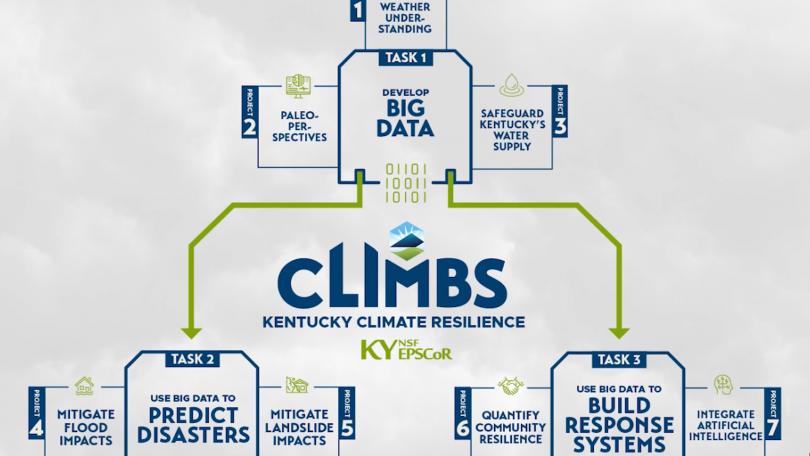A Q&A with Michael M. McGlue, professor in the Department of Earth & Environmental Sciences, and Sebastian Bryson, chair of civil engineering in the Stanley and Karen Pigman College of Engineering, about the $20 million collaborative project to build climate resilience in Kentucky
By Jennifer T. Allen

University of Kentucky faculty are part of a team leading a recently announced five-year Research Infrastructure Improvement (RII Track-1) award from the National Science Foundation’s Established Program to Stimulate Competitive Research.
The foundation is investing $20 million in advancing Kentucky’s climate resiliency, using a collaborative, statewide approach. Through the project, “Climate Resilience through Multidisciplinary Big Data Learning, Prediction & Building Response Systems (CLIMBS),” UK will lead an eight-institution collaboration with the University of Louisville, Western Kentucky University, Northern Kentucky University, Morehead State University, Eastern Kentucky University, Murray State University and Thomas More University.
The CLIMBS leadership team includes Michael M. McGlue and Edward W. Woolery in the College of Arts and Sciences’ Department of Earth & Environmental Sciences; Sebastian Bryson, chair of civil engineering in the Stanley and Karen Pigman College of Engineering; Rodney Andrews, program director of Kentucky NSF EPSCoR; and workforce development co-PI Czarena Crofcheck.
We recently sat down with McGlue and Bryson to learn more about the project’s goals, effects and statewide collaboration.
Q: Can you tell us about the project and how it came about?
Bryson: The project is a collaboration between the Department of Civil Engineering in the Pigman College of Engineering and the Department of Earth and Environmental Sciences in the College of Arts and Sciences. The idea is that we're looking at the big-picture problem of climate — impacts, changes and goings on with hazards in the Commonwealth of Kentucky.
McGlue: We're really interested in building capacity across the universities in Kentucky to address the problem of climate change and to build climate resilience, ultimately in the communities of the Commonwealth. Our goal is to become better at understanding how the climate is changing and how we can build resilience to those changes and translate those learnings to people across the state.
Q: What does the project intend to do?
McGlue: One of the main objectives of the project is to build a critical mass of expertise and facilities across the universities of Kentucky, to become better and more skilled at understanding this whole concept of climate resilience.
As a group, we identified early on that we had some deficiencies in those areas and given the recent events in the state's environmental history. There have been several big, catastrophic floods, some extreme weather and major landslide activity. We want to improve our capacity to help. That was the driving force behind the development of the proposal.
Bryson: When we're talking about building capacity, we'll do things like install environmental sensors and monitoring devices in various communities to establish relationships between the changing climate and, the frequency and intensity of hazards, and the responses of these communities to these hazards. The goal is to develop climate-resilient communities.
I t's one thing to say that catastrophic events such as floods and landslides have a direct impact on the communities where the physical infrastructure is destroyed, or people are displaced. But it's another thing to think about the psychological impacts on the communities themselves, or to think about the long-term economic impacts to the communities, not related to replacing the damaged and destroyed infrastructure. This project is supposed to help us understand how the climate is changing and how that changing climate will affect these various hazards that these communities are experiencing. And then, how these hazards impact the communities themselves — the people and the infrastructure of those communities.
t's one thing to say that catastrophic events such as floods and landslides have a direct impact on the communities where the physical infrastructure is destroyed, or people are displaced. But it's another thing to think about the psychological impacts on the communities themselves, or to think about the long-term economic impacts to the communities, not related to replacing the damaged and destroyed infrastructure. This project is supposed to help us understand how the climate is changing and how that changing climate will affect these various hazards that these communities are experiencing. And then, how these hazards impact the communities themselves — the people and the infrastructure of those communities.
Q: You’ve spoken about some of the major climate-related events we’ve seen in the recent past in Kentucky. How will this research directly impact our citizens?
Bryson: Climate change is happening now. We see the results of this change through greater variability of the weather, and consequently, more hazards of greater severity. This research is critical because it is not just here in the Commonwealth. It is all over the country and world.
McGlue: That's right. And many citizens in our state are vulnerable and at risk because of associated issues that stem from a change in climate. There are vulnerabilities across the state, and much of this work aims to address them and make our communities stronger.
Q: The CLIMBS project spans eight universities. Why is this large collaboration important?
Bryson: This collaboration across the Commonwealth is needed because climate change is a very big problem. So consequently, one university cannot do it alone. It was important that we include the expertise of multiple universities across the Commonwealth.
 McGlue: That's right. And I think another reason why the collaboration and the broad scope of the participation is important is because we want to train students statewide. Ultimately, a big objective for the program is to get students educated about these issues and to make them ready to get into the workforce to help address the problem. And that can't happen at simply one university. It must be a broad statewide approach.
McGlue: That's right. And I think another reason why the collaboration and the broad scope of the participation is important is because we want to train students statewide. Ultimately, a big objective for the program is to get students educated about these issues and to make them ready to get into the workforce to help address the problem. And that can't happen at simply one university. It must be a broad statewide approach.
Bryson: The universities across the Commonwealth have all performed research and developed educational programs along the lines with climate change and hazard engineering. But this problem, this project, allows us to now assemble all the different universities that are doing this type of research and all the different resources and bring all of that to bear into training the next generation of climate professionals.
Q: Please expand on the type of impact you see this research having.
Bryson: We have two community groups we are thinking about with this program – the academic community and the concept of training students and providing professors and faculty opportunities to do impactful research, and the larger communities of the Commonwealth. This project is geared toward Eastern Kentucky communities. We are looking at a lot of the communities in Appalachia and how climate change is affecting them in their daily lives.
McGlue: One of the motivations for proposing this type of research was an absence of a critical mass of experts who are capable of of studying climate change and climate resilience and teaching students, and the science and engineering behind that critical problem. A big part of the effort for this award will be to build up expertise and capacity across the universities, to provide greater capacity and greater skills that are necessary to address the problem.
Q: This is a five-year award. What do you want to accomplish within those five years and what happens after?
McGlue: It’s initially a five-year award. That five-year period is meant for the different university participants to build their research capacity, to hire new faculty and to train graduate and undergraduate students. That's the core mission for the first five years. What the hope is downstream is that once that expertise and capacity is built within the universities across Kentucky, we will be in an excellent position to continue the research, to continue the monitoring efforts and get to prediction and detection of some of the major hazards that go along with the changing climate. We hope that will carry forward in perpetuity into the future.
Bryson: Yes, that's right. The concept is we'll be hiring researchers and purchasing equipment that will help us do the actual research. So after the actual five-year award is over, we will have many different awards and different proposals and research projects that will be borne out of this effort. We will continue this research beyond the actual project because we will build capacities in our communities, and hopefully we will have made some of our communities within Eastern Kentucky more resilient.
Going forward, one of the things we will do is continue to monitor the increase in resiliency of these communities and then try to replicate that in other communities within the Commonwealth.
 McGlue: I think everyone on the team acknowledges that in order for the state to become stronger, in order for communities to build this resilience, we need to have strong earth and environmental science and strong civil engineering in our universities, because that's really where the core of the knowledge is coming from.
McGlue: I think everyone on the team acknowledges that in order for the state to become stronger, in order for communities to build this resilience, we need to have strong earth and environmental science and strong civil engineering in our universities, because that's really where the core of the knowledge is coming from.
And so it really was quite a thoughtful and intentional approach towards building a sustainable strength in those areas for many, many years into the future. We will be producing students across the state who are knowledgeable about these issues, have up-to-date skills, and can go out into the communities and make a difference.
It would be impossible to address all the issues and build a climate of resilience if we focused exclusively on one area. For example, there's a lot of expertise at Western Kentucky University around atmospheric science and meteorology, whereas here at UK, the core competence tends to be more in civil engineering and earth environmental science. And it varies depending on where you are in the state.
So bringing all of these folks together was really beneficial in the development of the project to better understand what the needs are, how can we address them, and what's the best strategy to keep that going after the life of the award concludes. We hope with what we've constructed here, we will see effects and benefits from this many decades into the future.
Q: Are there additional outcomes you hope will come from this project?
Bryson: One thing that that has not been brought up is the types of innovations we think will be borne from this research and some of the things that we hope will be developed such as true predictions of climate-driven geologic variables such as soil moisture, soil temperature, soil water storage capacity, and how various different watersheds will respond to the changes in climate. The innovations that we're going to be doing here are that concept of true real-time predictions, true real-time visualizations, that kind of thing has not been done in Kentucky.
We also will have the innovations that one of our projects will look at the interdependencies of all the different systems that make up a community. For example, the water systems, the communication systems, the energy systems, and the transportation systems are all interdependent. Our research will establish how these systems are interdependent, and how those interdependencies are influenced by the changing climate conditions. That's something that has not been done.
Q: Can you elaborate on the use of artificial intelligence and machine learning in this project?
McGlue: One aspect of the project that sometimes goes unnoticed, but is nevertheless really important, is the use of artificial intelligence and machine learning in understanding these large data sets. We're going to collect real-time environmental data in many areas to predict when hazardous events might occur. Ultimately, we hope that will help to improve emergency and disaster management and preparation. But AI and machine learning play a big role in understanding those big data sets.
That's another thing that students in the project will get the benefit of – they'll get training in the most modern artificial intelligence and machine learning techniques as applied to the environment. This develops the state’s future workforce, and hopefully carry forward to a more prepared, community-level climate resilience.
Bryson: Another benefit is that the large data sets we will have will be made available to researchers from all over the world. So not only will we be using all that data to develop our models and train our own people, but we will make be making that data available to the general public. We hope that not only will our research and our efforts affect what's going on here in the Commonwealth, but we hope that it will affect and impact what's going on around the world.
Q: What is the main takeaway of this research for Kentuckians?
McGlue: One of the important takeaways from all of this is that the goal of the climate program is to help Kentuckians. Ultimately, stronger earth science and stronger civil engineering across the state will help the people of the Commonwealth become more prepared and less at risk from the deleterious effects of climate change. That's really the overarching goal of the project — to help Kentucky’s communities become more resilient.
